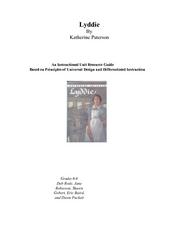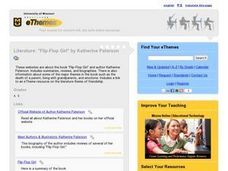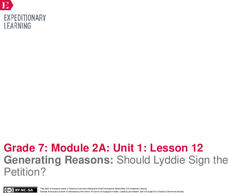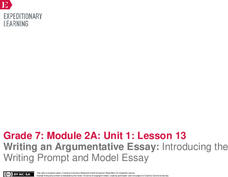Curated OER
Bridge to Terabithia: Visualizing to Optimize Comprehension
Good readers visualize. And in our image-rich culture it is imperative that children are provided with opportunities to practice this important skill. A selection from Shel Silverstein’s Where the Sidewalk Ends and Bridge to Terabithia,...
Curated OER
Jacob Have I Loved: Semantic Feature Analysis Chart
Do not allow your pupils to ignore the connections among the characters in Katherine Paterson’s Newbery Medal winning novel, Jacob Have I Loved. Instead, provide them a semantic feature analysis chart that asks them to note things Louise...
Curated OER
Lyddie: An Instructional Unit Resource Guide
Katherine Paterson’s young adult novel Lyddie is the foundation of a differentiated instruction unit that not only explores the rise of industrialization and labor but women’s rights issues as well. After learners read the novel, they...
Curated OER
QAR - Jacob Have I Loved
What kinds of questions could be asked with different pieces of literature? Use QAR questions to help your middle schoolers develop the skills to find information in a text. Thorough directions, a text excerpt, and a set of reading...
Curated OER
Bridge to Terabithia Study Questions and Essay Topics
In this online interactive literature worksheet, learners respond to 13 short answer and essay questions about Katherine Patterson's Bridge to Terabithia. Students may check some of their answers online.
Curated OER
Bridge to Terabithia Quiz
In this online interactive reading comprehension worksheet, students respond to 25 multiple choice questions about Katherine Patterson's Bridge to Terabithia. Students may submit their answers to be scored.
Curated OER
"FLIP-FLOP GIRL" BY KATHERINE PATERSON
Students explore websites about the book "Flip-Flop Girl" and author Katherine Paterson. There is also information about some of the major themes in the book such as the death of a parent, living with grandparents, and emotions.
Curated OER
Analyzing Relationships
Young scholars explore relationships between story characters. In this story elements and reading comprehension lesson, students generate character traits of the characters in Bridge to Terabithia, by Katherine Paterson. Young scholars...
Curated OER
Bridge to Terabithia
Students read Katherin Paterson's novel, Bridge to Terabithia and participate in a variety of enrichment activities. Lesson provides study questions for each chapter of the novel.
Curated OER
Photographs from the Great Depression: Jacob Have I Loved 
Students research the Great Depression and World War II. In this Great Depression lesson, students analyze photographs of the depression era as they begin reading Katherine Paterson's Jacob Have I Loved.
Curated OER
Do You Have Character?
Sixth graders read Katherine Paterson's novel, Bridge to Terabithia, and watch a video of Maurice Sendak's book, Where the Wild Things Are. They examine the characters in both stories that share similar characteristics. Students use the...
Curated OER
Bridge to Terabithia
Young scholars explore scenes from Katherine Paterson's book, Bridge to Terabithia. In this visualization lesson, students listen to the story read aloud. The young scholars then choose words and phrases that paint a picture in their...
EngageNY
Close Reading to Learn about Lyddie’s Character
Scholars work in pairs to analyze the characters, plot, and setting of Katherine Paterson's novel, Lyddie. Next, they apply what they learned about the characters' feelings and motivation to perform a mini reader's theater.
EngageNY
Analyzing Word Choice: Understanding Working Conditions in the Mills
Ravenous or hungry, happy or ecstatic—why does word choice matter? Scholars continue to analyze working conditions in the mill and how the conditions affect the protagonist of Katherine Paterson's novel, Lyddie. They engage in a close...
EngageNY
Launching Lyddie
Pupils engage in a close reading of chapter one of Katherine Paterson's novel, Lyddie. After answering text-dependent questions based on their reading, they complete reader's notes about how the setting, characters, and plot interact.
EngageNY
Modeling Entry Task, Reading Notes, and Reading Strategies for Lyddie
Readers understand a text better when they discuss it with someone else. Scholars continue reading the novel Lyddie by Katherine Paterson, engaging in text-related discussions with five classmates. Next, they add to their chapter three...
EngageNY
Analyzing Character: Who is Lyddie?
Character analysis can help readers feel more connected to a literary text. Scholars explore the topic by writing an acrostic poem about the main character from Katherine Paterson's novel, Lyddie. Then, pupils watch a short video to help...
EngageNY
Introducing Working Conditions in the Mills
Scholars discover how working in a textile mill in the nineteenth century affected the title character from Katherine Paterson's novel, Lyddie. Partners analyze quotes from the novel and then add evidence and questions about working...
EngageNY
Mid-Unit Assessment about Working Conditions in the Mills
Pupils demonstrate their knowledge of how setting impacts character development by completing a mid-unit assessment based on Katherine Paterson's novel Lyddie. They answer multiple-choice questions and cite textual evidence to explain...
EngageNY
Analyzing Textual Evidence: Working Conditions in the Mills
Deafening, dusty, debris. Such were the working conditions in the 1800s textile industry as portrayed in Katherine Paterson's novel Lyddie. Scholars watch a short video clip about life and work in the mills. Next, they work with partners...
EngageNY
Framing Lyddie’s Decision and Practicing Evidence Based Claims
Scholars grapple with whether the title character of Katherine Paterson's novel, Lyddie, should sign a petition about working conditions at the factory. They engage in close reading and discussion before adding their thinking about the...
EngageNY
Forming Evidence-Based Claims: Should Lyddie Sign the Petition?
Pupils reread selected passages from Katherine Paterson's novel Lyddie. After they finish, individuals gather textual evidence supporting whether Lyddie should sign a controversial petition and record their findings on graphic organizers.
EngageNY
Generating Reasons: Should Lyddie Sign the Petition?
Scholars synthesize evidence from Katherine Paterson's Lyddie to create a list of the pros and cons of Lyddie signing a petition about working conditions. They use the Lyddie's Decision anchor chart to record their thoughts and ideas...
EngageNY
Writing an Argumentative Essay: Introducing the Writing Prompt and Model Essay
Pupils begin the writing process in preparation for an end-of-unit essay based on Katherine Paterson's Lyddie. To get started, they read and discuss a model essay and learn about the similarities and differences between argumentative and...

























